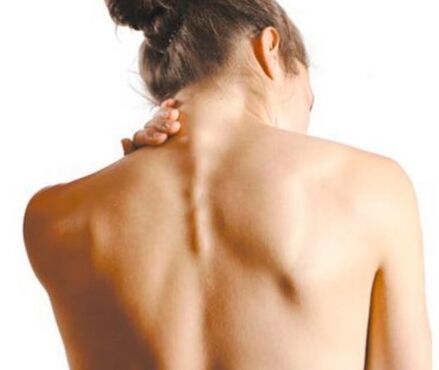Among all diseases known to humanity, most commonly the disease of the supporting motor tools. It is not possible for people to over 40 who will not have problems with the spine, not complaining of joint or muscle pain. The cause of this phenomenon is most often an inactive lifestyle, when, with age, with a decrease in motor activity, salt and other harmful substances stored in joints that interfere with the functioning of the bone system. It is generally accepted that support and motorcycle diseases only appear in mature people, but, in recent years, young people are often diagnosed with such diseases. It is quite difficult to treat the disease, especially when degenerative - a dystrophic change that affects cartilage, bones, and nerve tissue in the tissue. Among some diseases that violate the structure of the bone system, a special place is given to diseases such as cervical osteochondrosis, which is considered the most common disease of our time and is found not only in mature people, but also young people under the age of 35.

Osteochondrosis of the cervical area is a progressive disease, so treatment soon and then find a doctor - spina, can cause human defects. What is this dangerous disease? What are the symptoms of cervical osteochondrosis and how to deal with the disease?
How does cervical osteochondrosis develop?
Cervical osteochondrosis is a progressive disease characterized by degenerative changes - dystrophic in the intervertebral disc presented, altering their structure, which causes some significant symptoms. Risk for the development of osteochondrosis of the cervical area is a person who leads an inactive lifestyle or its professional activity associated with the body in one position for a long time. In terms of occurrence of osteochondrosis, damage to the second cervical spine after lumbosacral osteochondrosis. The specialty and complexity of the disease is that the cervical area wounds almost always affect the nerve root of the spinal cord and intervertebral disc, as a result large and small vessels are defeated by blood supply to the brain.
The cervical compartment has a complex structure and consists of 7 vertebrae, each performing several functions: supporting the head, turning on, bending the neck and other important functions. There is an intervertebral disc between the vertebrae, which makes the spine flexible and durable, and the intervertebral disc itself is made up of fibrous rings, where there is a pulp nucleus. The cervical vertebra suits each other, which is why even small physical activity can cause their displacement, which in turn causes blood and nervous vessels. In the cervical spine is a vertebral artery responsible for blood supply to the brain. When compressing, blood supply is disrupted, the brain does not receive a sufficient amount of important substance, which leads to defeat and development of several complications, which can cause patients' defects or even death.

The main cause of cervical osteochondrosis
Despite the prevalence of this disease and achievement in modern medicine, the pathogenesis of cervical spinal osteochondrosis is not fully studied. It is known that the disease can develop with the background of the metabolic impaired process in the cervical spine, which over time leads to changes in the structure of the intervertebral disc and the vertebral body. Among other types of osteochondrosis, the cervix is the most dangerous, as during its development there is a compression of the spinal cord and blood vessels, which certainly leads to a violation of blood supply to the brain cells. In the pathogenesis of the disease, doctors distinguish several provocative factors that can lead to the development of the disease.
- An inactive lifestyle.
- Violation of metabolic processes in the body.
- Salt deposition in the cervical region.
- An improper or unbalanced diet;
- Body length interruptions in one position: working on a computer, driving a car.
In addition to factors that can lead to the development of cervical osteochondrosis, experts distinguish people at risk for the development of the disease.
- Genetic predisposition.
- Cervical spinal injury.
- Long or periodic hypothermia.
- Hormone imbalance.
- Chronic illness and motor support tools: rheumatism, scoliosis, systemic erythematosus lupus.
- Excessive weight.
The reason for the development of cervical osteochondrosis may be another cause, but in any case of disease should be treated at its first sign.
How to recognize osteochondrosis of the cervical area and what are the signs?
The clinical signs of cervical osteochondrosis osteochondrosis of the cervical spine develop slowly. Symptoms of the disease depend on the level and number of damaged vertebrae and pinch the nerve endings. The main symptoms of the disease are different intensity in the spine, neck, lower back, given to other organs. Only a doctor can diagnose "cervical osteochondrosis" after the results of the examination, as the variety of clinics of the disease often resembles other pathologies, but everyone can suspect the disease.
- The pain in the neck, which gives the back of the head, ear, front, arm, chest, shoulder. The painful sensation of different intensity is enhanced with a minimum load or head turn.
- Numbness from the top and bottom, burning, tingling.
- Headache, dizziness.
- Damage.
- Dark in the eyes, "flies" in front of the eyes.
- Fainted with a sharp head turn.
- Sound in the ear.
- Language numbness.
- Coordination violations.
- Reduces hearing, visual acuity.
- It hurts in the heart.

The clinical signs of osteochondrosis of the cervical area, expressed, and appear as developed disease and progress. The doctor involved in the treatment of the disease distinguishes some of the cervical osteochondrosis syndrome, each has its own characteristics, and is shown depending on the damaged nerve spine.
- Rest syndrome - develops as a result of pinching the first pair of nerves in the cervical spine. The patient feels severe pain in the neck, which is given to the shoulder blade, lower back, shoulders and lower arm.
- The spinal artery syndrome is characterized by a pulsating headache in the back of the head or temporal region. The pain that burns the syndrome in the neck and nape, which increases when turning on the head, sleeping or coughing, gives it to the chest and shoulders.
- Cardial syndrome is a group of symptoms that initially resemble the symptoms of angina pectoris. This syndrome develops in the event of damage to the diaphragm nerve spine or large chest muscles. The main signs are considered to be destroying pain in the heart that do not pass after taking nitroglycerin. Such pain can last for several hours, increasing when driving or deep breathing. In patients, such symptoms cause panic, as they resemble heart attacks.

Symptoms of cervical osteochondrosis
Cervical osteochondrosis - symptoms and treatment directly depend on damaged nerve spine. The number of cervical roots is 8, and the cervical vertebra is 7. Each cervical nerve is above the vertebra and with damage has its own symptoms.
In the event of the first and second cervical vertebra defeat (CI-II), then the back sensitivity of the head will be disrupted, which attracts pain in the parietal and occipital region.
The ending nerve injury (C3) is extremely rare, but however, when it is damaged, the patient feels numb, in the pinching area. Speed, language sensitivity is also affected.
C4 nerve spinal cord causes pain and numbness in the collar or shoulders. Disorders in the respiratory system, liver pain is observed.
If the vertebral segment of the 5th department is interrupted, the patient will feel the pain spreading on the shoulder, the outer surface of the shoulder, the upper and lower sensitivity are also disrupted.
Pinching the C6 and C7 roots are the most common phenomena in patients. The patient feels pain in the neck, blades, arms, back, lower back, hand sensitivity, disturbed fingers.
When the nerve spine is affected, the pain will spread throughout the neck, back, elbows, and give it to the lower limbs. Fingering folly -Smaller on the arms and legs is observed, skin sensitivity is impractical. The feet and hands have the color, as blood circulation is affected.
In addition to the pain syndrome, patients with cervical osteochondrosis also complain of other diseases described above in the symptoms of the disease: impaired vision, dizziness, fainting, and others.
Media Physical Education for cervical osteochondrosis
It is necessary to perform and conduct physiotherapy exercises only after consulting a doctor. In addition, the movement should discuss each execution with a specialist, as the proper neck or limb position can even be more harmful to health and worsen treatment. Consider some safe exercises that can and should be done for patients with cervical osteochondrosis.
- In a position lying on a flat surface - spread your arm to the side. Raise your hands, rotate your body with a slightly left, right light. Your left hand palm touches your right hand and vice versa. Do such exercises 5 - 6 times.
- In a position to lie on the stomach, stretch your arms throughout the body. Try to relax your muscles and slowly turn your head to the left, then to the right. It should try to make the ear edge touching the floor. Such exercises can be done, as in the photo. Do 8 - 10 times.

- Lying on your stomach, try to lean your chin on the palm of your hand, your neck muscles must be relaxed. Do 5 times.
- Drink your head a little, then gradually lower it. The neck muscles will oppose, so such exercise must be carefully done. Repeat training 5-6 times.
- You need to get up properly, straighten your shoulders. Then slowly turn your head to the right, then to the left. So 5 - 6 times.
- Speak your finger behind the head, place your elbows together, place your lower arm chin. Try to raise the lower arm as high as possible. Repeat such exercises 5 - 6 times.
- Take your knees. With slow movements, lift your head and freeze the body down, stretching your arms forward. So 5 - 6 times.
Physical education is quite effective in the treatment of cervical osteochondrosis, but all exercises must be done regularly and properly. Of course, this situation doesn't improve from the first class, so you must be patient.
Treatment of osteochondrosis of the cervical department with folk remedies
Traditional medicine also shows its effectiveness in the treatment of cervical osteochondrosis, which in hundreds of years has collected a large number of recipes in weapons that will help reduce the symptoms of the disease. Treatment of osteochondrosis with folk medicine is to use vegetable and animal products for external or internal use.
Recipe 1. Honey from cervical osteochondrosis. You need 1 - 2 teaspoons of natural bees honey, 2 tablets of mummy. Honey and mummy should be heated, place a warm scarf and attach it to the neck for the night. Honey has an anti -inflammatory property, a clear biostimulation, so it can complete the treatment of the disease properly.
Recipes 2. Celery from osteochondrosis. 4 - 5 grams of celery should be poured with 1 liter of boiling water, insist 2 - 4 hours, tension and take 1 tablespoon 3 times a day.

Recipe 3. Boil chamomile oil and olive. You will need 30 grams of chamomile flowers, 0. 5 l of non -listed olive oil. Chamomile flowers need to be poured into oil, wear small heat, boil and let cool. You need to claim the stew for 2 days, then tighten it through full and rub the sick area with the resulting oil. With chamomile, other herbs can be used: Celandine, Calendula, St John's Wort. If there is no olive oil in the hand, then you can take the sunflower.
There are other traditional methods that help relieve the symptoms of cervical osteochondrosis. However, it is important to remember that such treatment is only effective at the onset of the development of the disease and can only be used in complex treatment with traditional methods.
Prevention
Prevention of neck osteochondrosis is an active lifestyle. In cases where there is a location for the development of the disease, it is necessary to visit a doctor - orthopedic. A place that is not important to food, which should be useful, rich in vitamins, minerals and useful ingredients. Excessive prevention or correction of weight, as well as frequent physical training, reduces the risk of developing cervical osteochondrosis several times.

















































